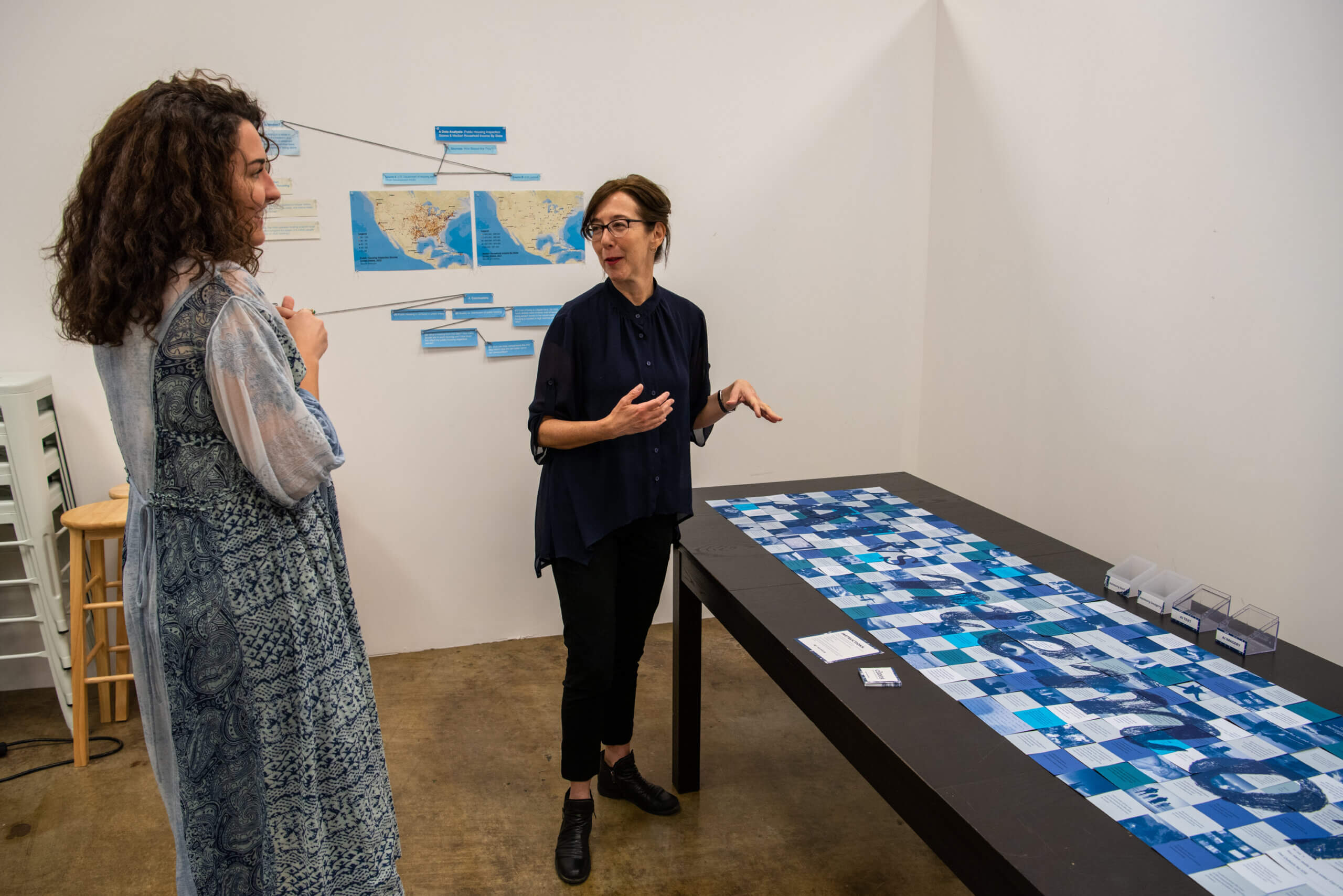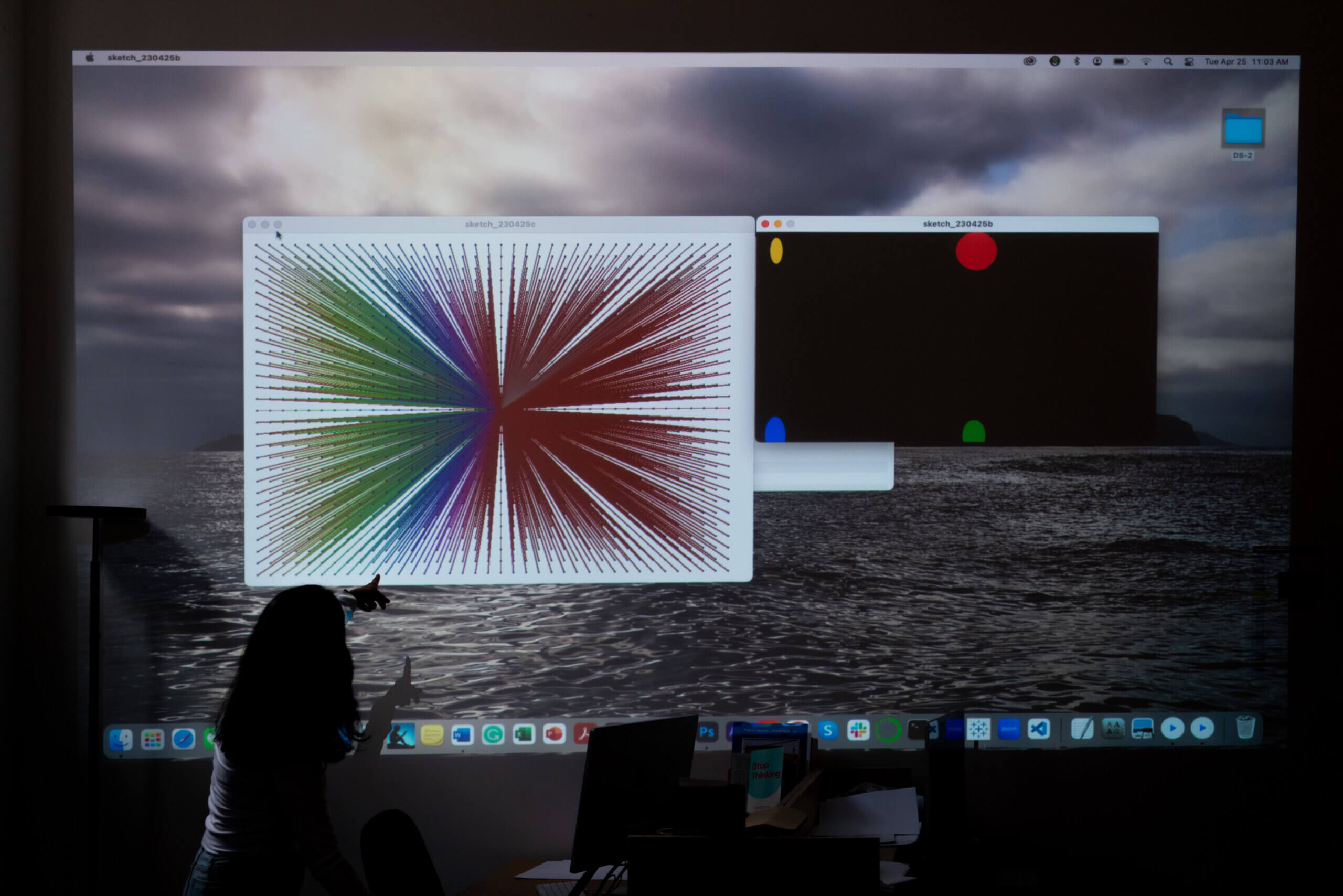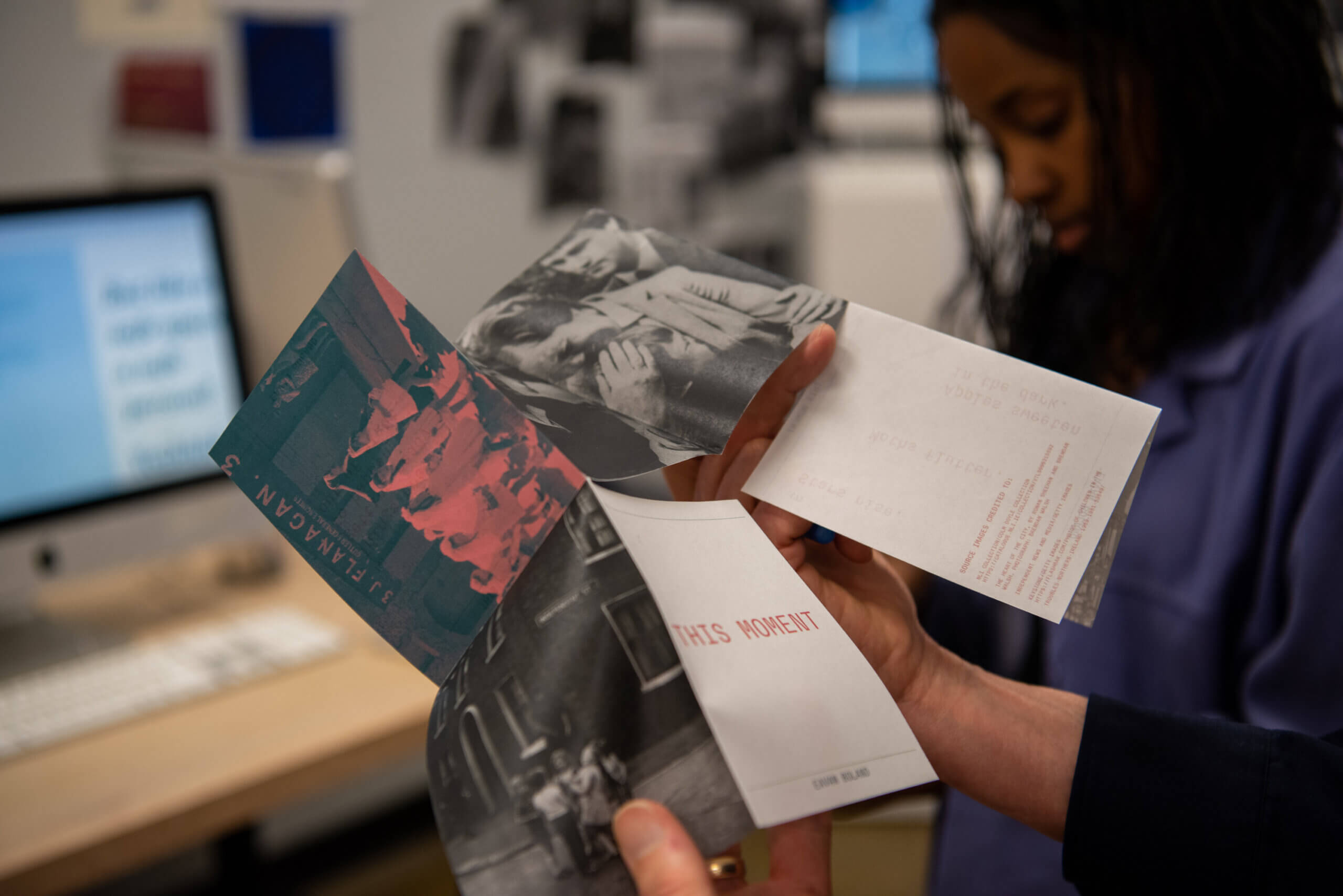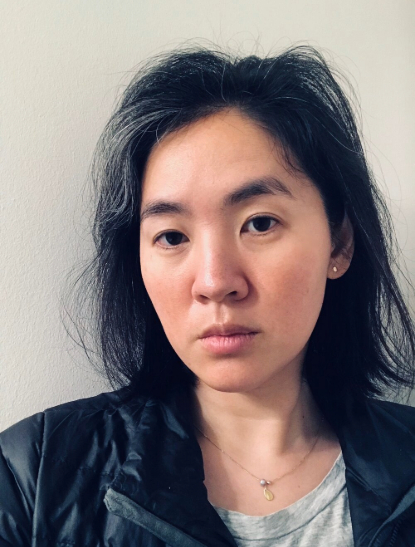The Department of Art & Design offers the following graduate programs:
MFA in Design
The Rutgers MFA in design immerses students in critical inquiry and experimental making, to design for a changing world. Combining studio work with speculative thinking, the program focuses on interdisciplinary research to inform the creation of publications, interfaces, information, and experiences. Students benefit from both the program’s intimate creative community and Rutgers’ vast opportunities for research and collaboration. Graduates emerge with an expanded skill set in ideation, prototyping, and production, prepared for design careers that contribute to the future of the arts, sciences, humanities and technology. This program is ideal for designers, artists and technologists who seek to initiate their own innovative work as well as contribute to and lead collaborative project teams. Click here to contact the Director and get more information on the program.
An outstanding feature of the program is the annual lecture series that brings renowned practitioners to speak directly with students. The series features creative directors; graphic, interaction and industrial designers; biohackers and programmers; writers, curators, and media theorists — all reflecting the multidisciplinary nature of the design field today and into the future. Take an inside look at one of our previous lecture series here.
Learning Goals of the MFA in Design
What students will know:
Upon graduation, students will possess the knowledge and skills to deploy a wide range of techniques to realize their creative goals; research and evaluate user and audience needs; employ critical language, both spoken and written, to analyze and evaluate their own and others’ work; design for a variety of media including print, time-based and interactive, effectively matching media to content; and will nurture literacy of historical and contemporary design, society, and culture.
What students will do:
Upon graduation, our students will be able to conduct interdisciplinary research; investigate and understand project goals and outcomes; define constraints and design strategies; initiate, develop and refine complex design projects; work effectively in a team, with peers and with experts in other fields of study; present work online, in print, and in an exhibition space; and defend their ideas in a written thesis.
What students will value:
Upon graduation, our students will have learned to value self-directed research and project development; interdisciplinary design practice; alternative, experimental, and speculative approaches; collaboration with makers and non-makers; criticality that informs making and assessing work; and design’s role in environmental and social justice.
Career Outcomes
This degree program could lead to careers in:
- Digital product design
- User experience design
- User interface design
- Design research
- Design education
- Creative leadership
- Creative project management
The MFA in Design is a two-year, full-time course of study to pursue studio work on a foundation of research and critical inquiry. Through seminars, studio courses and independent work, MFA Design graduate students develop skills to:
- Identify meaningful and appropriate subjects for design investigation
- Collaborate with research partners on complex projects that address cross-disciplinary concerns
- Visualize, design, prototype and produce ambitious, innovative projects
- Situate their work within current scientific, social, and political contexts
Throughout the program, the studio work is driven by the student’s interests and evolves through reading, reflective writing, presentations, class discussions, and critiques with faculty and peers. In the first year, each student chooses two university elective courses outside of Art & Design. These electives enable designers to engage more deeply with potential topics in the sciences, social sciences and humanities, serving as springboards for their creative work. In the second year, design courses address the development, production, display, and publication of the student’s thesis work.
The university offers a full range of academic departments; extensive libraries including the Rutgers Art Library; and interdisciplinary units such as the Institute for Research on Women and the Rutgers Center for Cultural Analysis. Rutgers provides considerable resources for interdisciplinary research. MFA in design students may tap into a diversity of fields of study and university units such as landscape architecture, user experience design, urban planning, biomedical engineering, packaging engineering, the School of Environmental and Biological Sciences (SEBS), the School of Communication and Information (SC&I), and more.
MFA in design students share a dedicated group studio space, with 24-hour access to facilities, labs, and shops for the duration of their studies. The program is situated in the Civic Square Building which houses computer labs, design classrooms, lighting studios, project spaces, and a 4,200-square foot-art gallery. See more details on the design area blog.
Every MFA in Design student receives a partial scholarship from Mason Gross School of the Arts, for each year of study.
Each student is also offered optional part-time employment in Co-Adjutant positions that support the operation of the undergraduate and graduate design area.
Additionally, there are select opportunities for teaching as a Part-Time Lecturer. These paid positions are not guaranteed, as they depend on enrollment, scheduling, and expertise.
Before assuming a teaching position, most students will shadow a faculty member in an undergraduate design course to learn teaching methods. Shadowing is unpaid, for course credit only. Mentorship and hands-on instructional experiences enhance the MFA student’s skillset for deeper critical engagement and future employment.
As a public institution, we are committed to supporting an economically diverse population. We aim to find the maximum financial assistance possible for MFA in Design graduate students in the most equitable manner possible.
Learn more about tuition and scholarship opportunities in our Admissions section.
The Rutgers MFA in design is a STEM-designated program. STEM stands for science, technology, engineering, mathematics. The US government grants a STEM OPT (Optional Practical Training) extension of 24 months for F-1 students who have completed a STEM degree and meet the other eligibility requirements. For details on the 24-Month STEM Extension and the latest OPT updates, visit Rutgers Global.
- Anukriti Kaushik
- Assem Kiyalova
- Chiyu Zheng
- Mahdokht Rezakhani
- Mahsa Masoumi
- Peyton Christopher Chiang
- Saba Maheen
- Yuxuan Hu
Visit our design blog for additional feature stories, alumni highlights, and resources.
MFA in Visual Arts
The Rutgers MFA in visual arts at Mason Gross School of the Arts was established in 1960 as the first non-disciplinary–specific fine art graduate program in the United States. Today the two-year, full-time program continues to flourish through the rigorous cultivation of dialogue, experimentation, and thinking across disciplines, media, approaches, and perspectives. All MFA visual arts students receive sizable, fully private, and autonomous studios with 24-hour access for the full duration of their studies including the summer between their first and second years. Studios are located at the Civic Square Building (CSB) or the Livingston Arts Building (LAB). All students, once trained, have 24-hour access to all facilities, labs, and shops within both buildings.
Notable MFA alumni include Alice Aycock, Matthew Day Jackson, Amy Feldman, Raque Ford, Mary Howard, Paddy Johnson, Jennie C. Jones, Alex Kwartler, Israel Lund, Jeanette Mundt, Sophy Naess, Clifford Owens, Pope.L, Wanda Raimundi-Ortiz, Charles Ray, Juan Sanchez, Mimi Smith, Joan Snyder, Keith Sonnier, and Wendy White.
Learning Goals of the MFA in Visual Arts
What students will know:
Upon graduation, students will possess the knowledge and skills to access the tools and professional resources important to their continued success; maintain and develop a self-driven research-practice from across the university and community in anticipation of an independent professional practice; situate their work in a critical genealogy; speak and write about their practice within their community of peers and the larger art worlds they will be engaging; use tools and techniques required for their creative work to a professional standard; conceive and present a professional exhibition of their work and manage a project with multiple deadlines; write about and defend their research and work within the field; develop/refine a syllabus, conduct critiques of advanced-level artistic practices, grade, and apply inclusive pedagogy within teaching and mentoring contexts.
What students will do:
Upon graduation, our students will be able to develop original creative research that offers new contributions to the field of contemporary visual art; explain and analyze their work through different critical, cultural and art-historical perspectives; forge and deepen connections and networks with peers, community as well as within larger field of contemporary art; create and apply new artistic tools and techniques in the generation of original work; develop, manage, and realize self-directed artistic research projects and bodies of work; develop a syllabus applicable to the area of their study; and teach an introductory-level college course in the arts applicable to the area of their study.
What students will value:
Upon graduation, our students will have learned to value interdisciplinarity: material, medial, technical, and discursive relationships between and within various artistic and cultural forms; experimentation, risk-taking, and developing novel forms of conceptualizing and creating; critical thinking in relation to one’s practice, the practice of others in the graduate community, and within the field at large; deepening one’s research and artistic practice; the shaping of contemporary culture; building an inclusive community of collaboration and exchange; mentorship and a pedagogical community or learners and teachers; engaging the world with a sense of curiosity and compassion as artist-citizens; and envisioning possibilities for a new world.
Career Outcomes
This degree program could lead to careers in:
- Professional contemporary artist
- Professional who requires subject matter expertise in contemporary art (director, registrar, arts project manager, conservator, critic, arts administrator, curator, museum professional, etc.)
- Professor/educator
- Creative leadership and creative project management in any field
- Specialized craftsperson, technician

The curriculum consists of graduate seminars, independent studies, first year reviews, and a thesis. Each semester we present multiple graduate seminars on issues, topics, and practices in contemporary art in relationship to students’ ongoing and developing studio work. As a major public research university, we offer a wealth of resources and opportunities. Students may choose to enroll in courses in other departments within the school and across the university. Graduate seminars are taught by the faculty and occasional guest lecturers such as Jason Hirata, Sondra Perry, Ronny Quevedo, Ohad Meromi, Jamie Isenstein, Halsey Rodman, and Zachary Fabri. MFA students also have the opportunity to study with the Tepper Family Endowed Chair in Visual Arts; past Tepper Chairs were Kara Walker, Catherine Murphy, and Park McArthur. Formal faculty reviews of student work take place in the first semester after student’s first-year exhibition followed by a studio review during the second semester. In the second year, students write a thesis statement, participate in a thesis exhibition, and give a formal presentation of their work followed by a final faculty review.
In line with the school’s belief that affordable graduate study in art should be available to all students, all accepted graduate students receive fellowships equivalent to the cost of tuition for the two years of the program. Incoming graduate students are awarded fellowships equivalent to full out-of-state tuition in their first year and full in-state tuition in their second year. (International students continue to receive out-of-state tuition in their second year). No additional applications or requirements are necessary to qualify for the fellowships. With the fellowships comes the expectation that graduate students will fully participate in the Art & Design Department community during their time at Mason Gross. Students are responsible for covering all additional university fees including health insurance, campus fees, housing, and materials. Students may apply for additional financial support through a host of department jobs.
The department also offers a range of paid co-adjunct positions which students may apply for each semester.
Graduate students interested in gaining teaching experience can do so via a for-credit, semester-long teaching mentorship under faculty supervision. Upon completion of the mentorship, students become eligible for teaching assignments as Lecturers. Graduate Lecturers are expected to maintain a full course load.
Note: Teaching assignments are neither guaranteed nor promised every semester. These are competitive opportunities, and offers are contingent upon faculty approval, class availability, enrollment numbers, student expertise, and satisfactory teaching evaluations. We do not offer teaching assistantships (TAs), and teaching is not a curricular component or requirement of the MFA program.
Class of ’25
- Alisa Sikelianos-Carter
- Ariana Martinez
- Daniel Lucal
- Emily Drew Miller
- Feyaz Yusuff
- Francisco echo Eraso
- Harley Hollenstein
- Ian Byers-Gamber
- JaLeel Marques Porcha
- John Martin
- Johnathan Wilborn
- Natalie Romero Marx
- Patricio Morocho
- Quinton Isaacs
- Rachel Mulvihill
- Sophia-Yemisi Adeyemo
Class of ’26
- Ana Rucker
- Andrew Jarman
- Emma Berry
- Graham Krenz
- Jake Paron
- Jules Garder
- Moshopefoluwa Olagunju
- Nate Millstein
- Nilo Goldfarb
- Shiva Addanki
- Terrell Halsey









